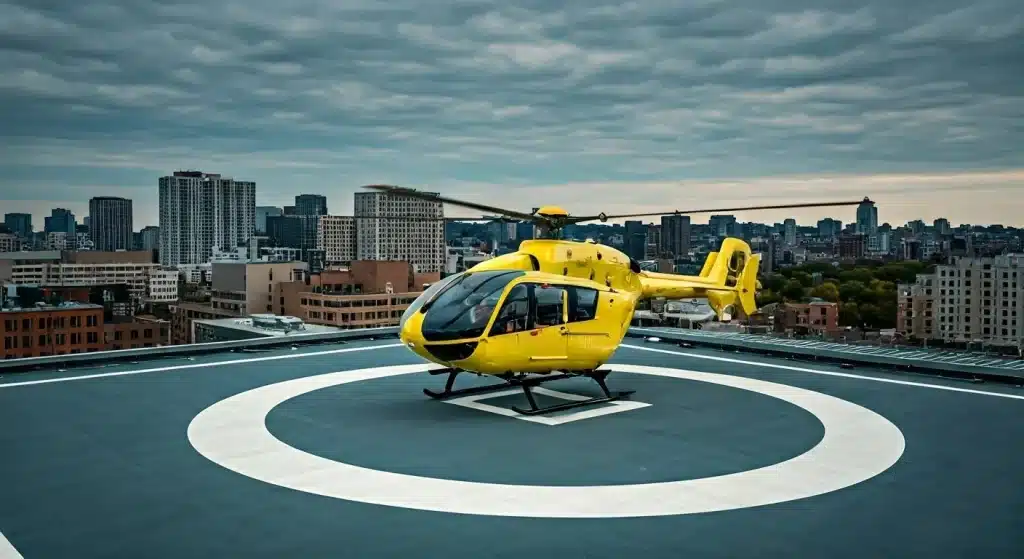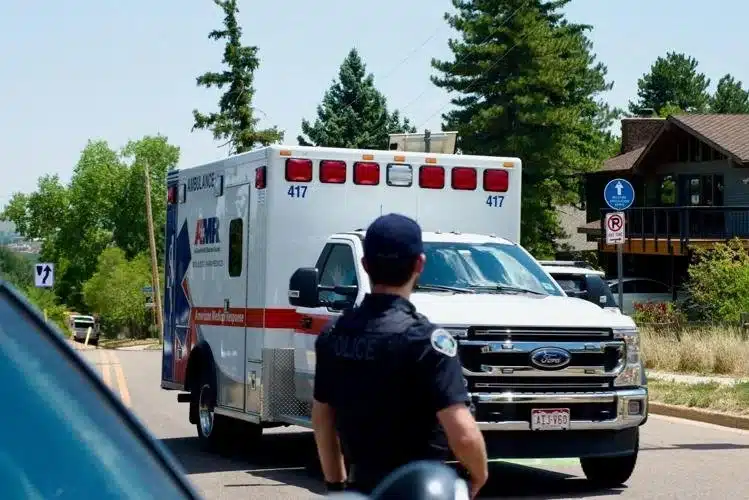Have you ever wondered if Medicare Ambulance Coverage helps when you need an ambulance or even an air ambulance during an emergency? Medicare Part B may pay for these services when you’re seriously hurt or sick and traveling by car or taxi could put your health at risk. This could mean a ground ambulance or, in urgent cases, a helicopter or airplane. But Medicare only covers them when it’s medically necessary. After you meet your Part B deductible and pay your premium, Medicare usually covers 80% of the cost, and you pay the rest.
Understanding these rules can feel overwhelming, but The Medicare Family makes it simple. Learn Medicare & Find the RIGHT Coverage by scheduling your FREE call today. We’re licensed in all 50 states, represent 30+ top insurance companies, and explain Medicare in plain English. With 40+ years of experience, we’ll help you compare top plans, choose the best one for your needs, and provide lifetime support – all at no cost to you. Book your appointment today and get peace of mind about your coverage.
When Does Medicare Cover Ambulance Services?
Medicare coverage for ambulance transportation depends on if you really need it for your health. In most cases, Medicare Part B pays for ambulance service when taking a car or taxi could put you in danger. If there’s an emergency, Medicare covers emergency ambulance transportation to the nearest good hospital or skilled nursing facility. This is true if you need urgent care and you can’t be moved safely in any other way.
When it comes to non-emergency ambulance transport, Medicare coverage is not as wide. You might still get covered if your doctor gives you a written order saying you need ambulance transportation for your health and safety. But not every non-urgent ride by ambulance transport gets covered, and you may need to meet extra rules like getting Medicare’s approval ahead of time.
Let’s look at how Medicare decides the difference between emergency and non-emergency ambulance transportation.
Emergency Versus Non-Emergency Ambulance Transportation
Medicare Part B covers ambulance transportation. This includes both emergency and some non-emergency trips. For emergency ambulance transportation, you must have a sudden health problem. These can be things like heavy bleeding, passing out, or a heart attack. You need care from a hospital or skilled nursing facility right away in these cases.
Non-emergency ambulance transport covered by Medicare Part B is stricter. It only pays if you have a written order from your doctor. The doctor must say that traveling any other way instead of an ambulance could be bad for your health. One example is if you have renal disease and need to go to a dialysis center. Medicare may cover this if it is needed for your health and is well documented.
Key points to remember:
- Emergency ambulance transport must be medically necessary.
- Non-emergency trips need a written order from your doctor and, in some states, approval beforehand.
- The ambulance must take you to the closest facility that can treat you – Medicare won’t pay for extra miles if you want to go farther.
- The ambulance company must follow Medicare’s rules for the service to be covered.
Next, let’s talk about what “medical necessity” means and look at the rules Medicare uses to decide if you are eligible.
Medical Necessity and Eligibility Criteria
Medical necessity is the cornerstone of Medicare ambulance coverage. Emergency services do not require prior documentation, but non-emergency ambulance transportation involves several steps to verify that it’s needed.
You’ll need a written order from your doctor explaining why an ambulance is necessary. In many cases, especially for scheduled, non-emergency transports, Medicare requires prior authorization. The rules on documentation and approval can vary by state, so always check local requirements before scheduling transport.
Here’s a text table outlining some typical eligibility criteria:
| Requirement | Emergency Transport | Non-Emergency Transport |
| Medical Necessity | Required | Required |
| Written Order from Doctor | Not required (assumed in emergency) | Required |
| Prior Authorization | Not required | Often required (varies by state) |
| Nearest Appropriate Facility | Yes | Yes |
| Advance Beneficiary Notice (ABN) | Not required | May be required if coverage is in doubt |
Now that you know when Medicare pays for ambulance services, it’s important to understand your potential out-of-pocket costs.
Out-of-Pocket Costs for Ambulance Services Under Original Medicare
Out-of-pocket costs for an ambulance service under Original Medicare can catch many people off guard. After you pay the yearly Part B deductible, you pay 20% of the Medicare-approved amount as coinsurance. The amount you pay can change. This depends on the ambulance fee schedule. It also depends on if your provider works with Medicare and accepts the assignment.
If you have a Medigap plan, it can help cover some or even all of your coinsurance costs. But if the ambulance service charges more than what Medicare approves, you might have to pay those extra charges.
Let’s look at these Part B costs a little more.
What You Pay: Deductibles, Coinsurance, and Copays
When you use ambulance services, you’ll first need to satisfy your annual Part B deductible. For 2025, the Part B deductible is $257. Once you’ve reached this amount, Medicare typically covers 80% of the approved ambulance charge, and you pay the remaining 20% as coinsurance. Some Medicare Advantage plans may use copays instead.
Let’s visualize these costs:
| Cost Element | Original Medicare | Medicare Advantage Plans |
| Part B Deductible | $257 (2025) | Varies by plan |
| Coinsurance | 20% of Medicare amount | Copay or coinsurance (plan specific) |
| Ambulance Fee Schedule | Applies | Plan may have a separate fee schedule |
| Medigap Coverage | May pay coinsurance | Not applicable |
Keep in mind, if your ambulance provider does not accept Medicare assignment, your costs could be higher.
Sometimes, Medicare may not cover an ambulance ride at all. Let’s look at situations where noncoverage may occur.
Scenarios Where Medicare May Not Cover Ambulance Services
There are times when Medicare will not pay for your ambulance transport. For example, if you ask for an ambulance ride but do not meet the medical necessity rules, or if you do not have a written order for non-emergency transport, you may need to pay the full amount. Your ambulance provider must give you an advance beneficiary notice (ABN) if they think Medicare will not cover the cost.
Here are some times when Medicare may not pay for your ambulance ride:
- The transport is for convenience and not due to a real medical need.
- You go to a farther facility even when there is a suitable one that is closer.
- You do not have a required doctor’s written order or there is no prior approval for non-emergency transport.
- An ambulance is used when another kind of vehicle would be safe enough.
If you get an ABN, you can appeal the denied claim. You should also check your Medicare Summary Notice for how to appeal.
Air ambulance transport has strict coverage rules with Medicare. Next, we will talk about how Medicare deals with air ambulance services.
Air Ambulance Coverage: Helicopter and Airplane Services

Air ambulance transportation, like using a helicopter or airplane, is covered by Medicare only under certain conditions. If you need to get urgent treatment and going by road would take too much time or put your health at risk, then Medicare may pay for air ambulance transportation to the closest proper hospital or a critical access hospital.
This coverage is just for times when using a ground ambulance is not safe or possible. The air ambulance transportation must be needed for your health. Medicare will only pay for a flight to the closest place that can treat you, like a hospital or a critical access hospital.
Let’s talk about when Medicare will agree to pay for air ambulance services.
When Are Air Ambulance Services Covered by Medicare?
Medicare covers air ambulance services, like a helicopter or airplane, when fast travel is vital for your health. This often happens if you are in a remote area or are in the middle of a medical emergency that is life-threatening. If a ground ambulance cannot reasonably get to you, then using air transport is a good option.
Here are examples of when air ambulance may be covered:
- Ground ambulances can’t get to your location, such as in a remote or blocked place.
- Your condition calls for fast transport to an appropriate facility.
- You must go to a critical access hospital or a special center not close by.
- You have end-stage renal disease and must use specialized transport for urgent dialysis.
For all air ambulance services that are covered by Medicare, you need a doctor’s written order. There must also be records showing medical necessity. If you pick a hospital that is farther away, Medicare covers only the part to the nearest place. You will have to pay the extra cost.
Conclusion
Understanding Medicare Ambulance Coverage can give you real peace of mind in an emergency. Medicare Part B helps cover ground and air ambulance services when they’re medically necessary, take you to the nearest appropriate facility, and follow the right rules – like having a doctor’s order or prior authorization for certain non-emergency trips. After you meet your Part B deductible ($257 in 2025), Medicare usually pays 80% of the approved cost, and you’re responsible for the rest unless you have extra coverage.
Want expert help at no cost? Learn Medicare & Find the RIGHT Coverage with The Medicare Family. We’re licensed in all 50 states, work with 30+ top insurance companies, and have over 40 years of experience helping seniors choose the best plans. We explain Medicare in plain English, compare your top options, and give you lifetime support – all for free. Schedule your call today and feel confident about your coverage.









